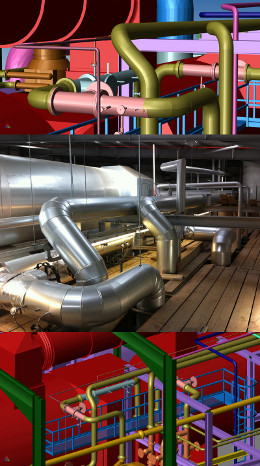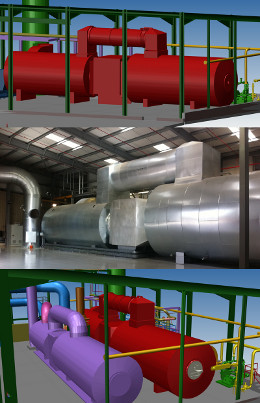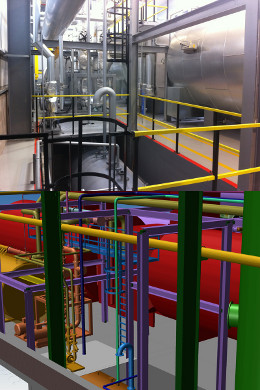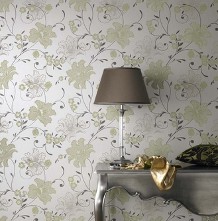Graham & Brown and MPDS4: Engineering Sustainability
Heat Recovery Incinerator Design with MPDS4
“MPDS4 let me incorporate existing 2D drawings and use them as a basis for 3D building and equipment design. It meant I could add intelligence to the design, finding the optimal routes for pipes and ducts and checking for clashes in space. The walk-through visualisation made it so much easier to present the design to our Board, operators and engineering staff, and detailed drawings automatically generated from the model meant clear instructions for all the contractors routing the electrics, gas, ductwork, pipes and compressed air installations.”
– Tony Conroy, Head of Engineering, Graham & Brown


About Graham & Brown
Graham & Brown, started by friends Harold Graham and Henry Brown in 1946 as a wallpaper manufacturer, transforms the walls of the world with inspiring wall decorations. The company supplies a huge variety of wallpapers and wall art, conceived by creative artists and designers from around the globe, as well as complementary paints in evocative colours (“The colours that made Britain Great”).
A story of grit and glamour, Graham & Brown is part of the rich industrial tradition of Blackburn, once a famous centre for textile manufacturing. Today the company is run by the third generation of the Graham and Brown families, and has divisions in the United States, France, Holland, Russia, Canada, China, and Germany, employing 560 people globally. Graham & Brown produces 21,700,000 rolls of wall covering annually; sells 685,000 wall decorations; consumes 41,000 tonnes of material, and has annual turnover of £70 million.
Bespoke Engineering
Non-stop Production
Heat Recovery

Taking control of the plant design

The Transition to 3D
Tony needed to design the gas and thermal oil pipework and air ducts, to be constructed in a limited space under strict regulatory compliance. Well aware of the benefits of spatial design with interference checking, he was keen to model the facility in 3D, if this could be done quickly and without a huge software implementation burden. “My main concern: I didn’t want to get all those pipes installed and then find out they clash. If there’s a problem, time is money. And we have to follow strict ATEX and DESEAR¹ regulations,” Tony continues. With hazardous conditions where pipes for thermal oil (operating at 275˚C) are routed near 9 inch gas mains, the location of flanges is essential, for example. Every detail has to be taken into consideration in the design.
Fast Results
Within days of the first product demonstration, Graham & Brown acquired the MPDS4 COMPLETE package, which includes 2D to 3D building and conveyor design with the Factory Layout module, along with all traditional engineering disciplines with automatic clash detection (P&ID, 3D piping, steel, ducting and electrical), the Engineering Review 3D walkthrough module, the parametric 3D Component Designer and the MPDS4 Project Manager tool. The database-driven large-scale layout software is well known for low implementation costs. Within 2 days, Tony was using the software productively. “It took me about 3 ½ weeks (and I was familiarising myself with the system on the job) to model the entire incinerator house with 2 incinerators, their thermal oil and air to air heat exchangers, motors, pump sets, exhaust stacks, the 100 tonne concrete slab and the 32 10-metre piles drilled into the ground to support the structure, along with all the pipes and ducts linking the process to the machinery sets on the factory floor.”
Tackling Complexity to Minimise Downtimes


Serious about Sustainability
Visualising the Future
With MPDS4, Tony is well armed to efficiently execute future projects, modelling existing production areas as the need arises. “This will allow me to make controlled, faster, less error-prone modifications to the factory, communicate visually with engineering staff, or cost scenarios where components need to be replaced. It will also allow me to create virtual factory walk-throughs to send to colleagues abroad, suppliers or customers.” he explains.
For Graham & Brown, where innovative engineering design meets creative home design, MPDS4 supplies the tools that allow decades of engineering expertise to be deployed productively immediately – helping a leading British manufacturer to grow sustainably for decades to come.
For more information about Graham & Brown, please visit www.grahambrown.com

